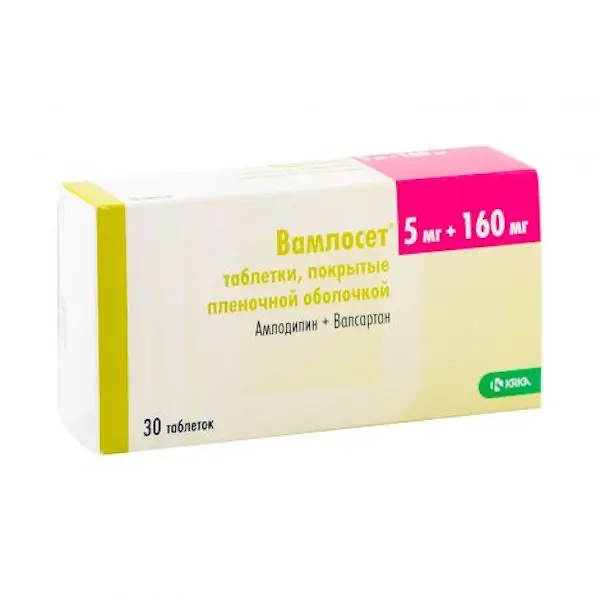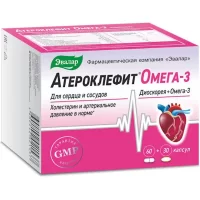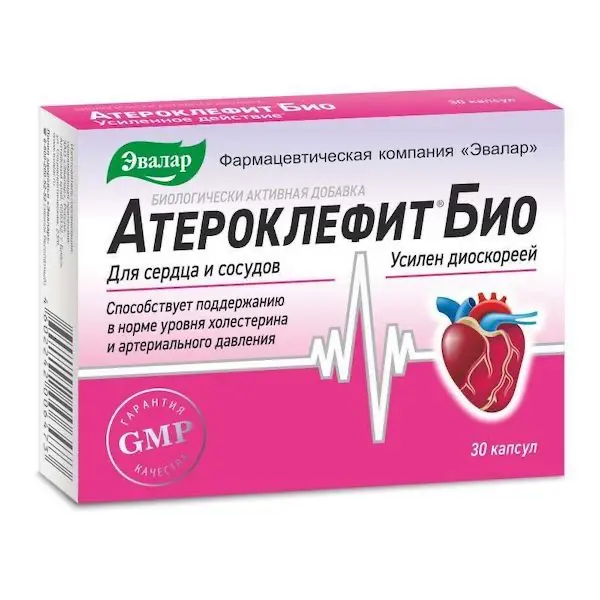Description
Vamloset Pharmacodynamics
A combined hypotensive drug containing two active substances with a complementary mechanism of blood pressure (BP) control. Amlodipine, a dihydropyridine derivative, belongs to the class of “slow” calcium channel blockers (CMCBs), valsartan belongs to the class of angiotensin II receptor antagonists. The combination of these components has a mutually complementary hypotensive effect, which leads to a more pronounced BP reduction compared to BP when they are used separately.
Indications
Arterial hypertension (patients who are indicated for combination therapy).
Contraindications
Hypersensitivity to amlodipine, other dihydropyridine derivatives, valsartan or other drug components;
Severe hepatic insufficiency (more than 9 points on the Child-Pugh scale), biliary cirrhosis and cholestasis;
Pregnancy and breastfeeding;
Severe renal insufficiency (creatinine clearance (CK) less than 30 ml/min), use in patients on hemodialysis;
Severe arterial hypotension (systolic BP less than 90 mmHg), collapse, shock (including cardiogenic shock);
Left ventricular outflow tract obstruction (including hypertrophic obstructive cardiomyopathy (HCMP) and severe aortic stenosis);
Hemodynamically unstable heart failure after acute myocardial infarction;
Primary hyperaldosteronism.
Concomitant use with aliskiren in patients with diabetes mellitus or impaired renal function (CKR less than 60 ml/min).
Safety of Vamloset usage in patients after kidney transplantation and in children and young people younger than 18 years old is not established.
Caution:
Mild (5-6 points by Child-Pugh scale) and moderate (7-9 points by Child-Pugh scale) hepatic impairment, as well as in obstructive biliary tract disease, mild to moderate renal impairment (CK 30-50 ml/min), unilateral or bilateral stenosis of the renal arteries or stenosis of the artery of the only kidney, chronic heart failure (CHF) of III-IV functional class according to the NYHA classification, hyperkalemia, hyponatremia, diet with restriction of table salt intake, decreased circulating blood volume (CBC) (incl. including diarrhea, vomiting), use in patients with hereditary angioedema, or edema on prior therapy with angiotensin II receptor antagonists (ARA II).
As with the use of other vasodilators, special caution should be exercised when used in patients with mild to moderate mitral and aortic stenosis.
Pregnancy and lactation:
Pregnancy .
The use of Vamloset is contraindicated in pregnancy.
Taking into consideration the mechanism of action of angiotensin II receptor antagonists, a risk to a fetus cannot be excluded by using the drug in the first trimester of pregnancy.
As any other drug that has a direct effect on the renin-angiotensin-aldosterone system (RAAS), Vamloset should not be used during pregnancy or in women planning to become pregnant. When using agents that affect the RAAS, women of childbearing age should be informed about the potential risk of adverse effects of these drugs on the fetus during pregnancy. If pregnancy is planned, it is recommended that the patient be transferred to an alternative hypotensive therapy, taking into account the safety profile. If pregnancy is diagnosed, Vamloset should be discontinued and, if necessary, transferred to alternative hypotensive therapy.
Vamloset, as well as other agents exerting direct influence on the RAAS, is contraindicated in the first and second trimesters of pregnancy because it can cause fetotoxic effects (impaired renal function, delayed ossification of fetal skull bones, oligohydramnios) and neonatal toxic effects (renal failure, arterial hypotension, hyperkalemia) and fetal death. If the drug was nevertheless used in the tenth trimester of pregnancy, an ultrasound examination of the kidneys and fetal skull bones should be performed. Newborns whose mothers have taken Vamloset during pregnancy should be monitored, because arterial hypotension may develop in a newborn.
Breast-feeding period.
It is not recommended to use Vamloset during breastfeeding. If it is necessary to use Vamloset during lactation, breastfeeding should be stopped.
Dosage and administration
- Orally with a small amount of water, regardless of the time of meal, once daily.
- Recommended daily dose is 1 tablet of Vamloset containing amlodipine/valsartan combination at a dose of 5/80 mg, 5/160 mg, 10/160 mg, 5/320 mg or 10/320 mg.
- It is recommended that Vamloset be started with a dose of 5/80 mg once daily. The dose may be increased 1 to 2 weeks after the start of therapy.
- The maximum daily dose is 5/320 mg (in terms of valsartan) or 10/160 mg (in terms of amlodipine) or 10/320 mg.
- Special patient groups:
- Amlodipine .
Patients with impaired renal function: no dose adjustment required.
Patients with impaired liver function: should be used with caution.
Elderly patients: no dose and dosing adjustment is required. - Valsartan .
Patients with impaired renal function: initial dose adjustment is not required in patients with impaired renal function /KC > 30 ml/min).
Patients with hepatic impairment: Valsartan is contraindicated in patients with severe hepatic impairment, biliary cirrhosis and cholestasis. The maximum daily dose of valsartan in mild to moderate hepatic impairment is 80 mg. Vamloset in doses of 5/160 mg, 5/320 mg, 10/160 and 10/320 mg is contraindicated. - Elderly patients: no dose adjustment is required.





